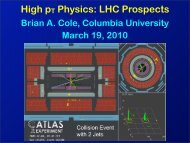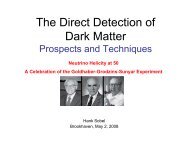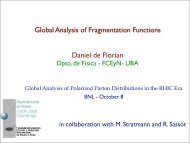One flavor QCD Abstract - BNL theory groups - Brookhaven National ...
One flavor QCD Abstract - BNL theory groups - Brookhaven National ...
One flavor QCD Abstract - BNL theory groups - Brookhaven National ...
Create successful ePaper yourself
Turn your PDF publications into a flip-book with our unique Google optimized e-Paper software.
Im z<br />
−m<br />
m<br />
Re z<br />
FIG. 5: As the mass changes sign a pole moves between inside and outside the overlap circle. This generates<br />
a jump in the condensate.<br />
when the quark mass vanishes. Furthermore, the earlier simple chiral Lagrangian arguments [8,<br />
30] indicate that no singularities are expected when a single quark mass passes through zero.<br />
Combined with the above discussion, this leads to the conclusion that for the one <strong>flavor</strong> <strong>theory</strong><br />
ρ(0) must vanish.<br />
This leads us to an amusing paradox. Consider the original path integral after the fermions are<br />
integrated out. Changing the number of <strong>flavor</strong>s N f manifests itself in the power of the determinant<br />
∫<br />
dA |D| N f<br />
e −Sg(A) . (40)<br />
Naively this suggests that as you increase the number of <strong>flavor</strong>s, the density of low eigenvalues<br />
should decrease. But we have just argued that with two <strong>flavor</strong>s ρ(0) ≠ 0 but with one <strong>flavor</strong><br />
ρ(0) = 0. How can it be that increasing the number of <strong>flavor</strong>s actually increases the density of<br />
small eigenvalues?<br />
This is a clear example of how the non-linear nature of the problem can produce non-intuitive<br />
results. The eigenvalue density depends on the gauge field distribution, but the gauge field distribution<br />
depends on the eigenvalue density. It is not just the low eigenvalues that are relevant to<br />
the issue. Fermionic fields tend to smooth out gauge fields, and this process involves all scales.<br />
Smoother gauge fields in turn can give more low eigenvalues. Thus high eigenvalues influence the<br />
low ones, and this effect evidently can overcome the naive suppression from more powers of the<br />
determinant.<br />
16






